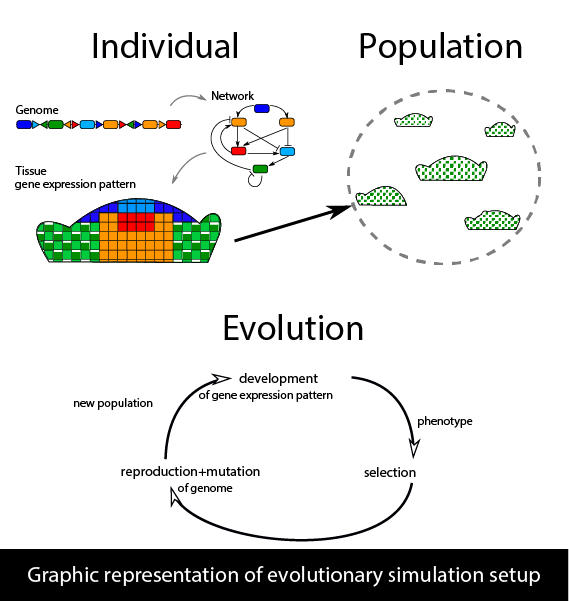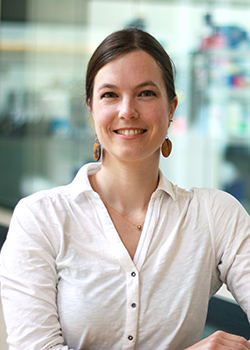Dr Renske Vrooman’s research group studies the evolutionary dynamics of developmental processes in biology with a focus on plants.
Plant evo-devo research
Understanding how multi-cellular life has changed and how undifferentiated cells have established patterning and shape to develop into complex organs helps tell us about how plants have evolved. By using an evolutionary developmental biology (evo-devo) approach, we can study the developmental programmes and patterns in tissues and organs from an evolutionary perspective.
Every multi-cellular organism originates from a single fertilised cell. The journey from single cell into a fully-grown plant, for example, is encoded mainly from the genome, but this requires coordinated interactions between cells and complex mapping.
Evolutionary simulation of migrating and dividing cells: We find that multicellular aggregates locate resources through emergent collective chemotaxis more efficiently than single cells; this emergent property enables evolution of adhesion.
What is driving the mechanisms behind a clump of undifferentiated cells differentiating into specialised tissues and organs? To attempt to understand the underlying developmental programmes, we are employing computational models to study the long-term evolution of plant development and integrating understandings of how gene regulatory networks and dynamical processes that generate complex morphologies can evolve.
Evolving multicellularity - from single cells to colonies and beyond: Dr Renske Vroomans discusses the evolution of multicellularity, which is one of the major transitions in evolution.
Mathematical models reveal evolution of plant organs
We research the evolution of plant organs, like branches, roots and leaves over long evolutionary timescales. Using mathematical models to simulate millions of years of plant evolution, it is possible to study in detail how, over evolutionary time, the accumulation of mutations leads to new developmental programs that make new organs. This gives us a broader understanding of the evolutionary design principles behind plant development.
Plant developmental evolution
The growth of plant organs is governed by a developmental program. This developmental program consists of the interactions of many genes that influence how the cells within a plant behave. As plants evolve, mutations may change the workings of their developmental program; many mutations lead to a malfunctioning plant, but some may lead to the appearance of a new organ.
Long-term evolutionary dynamics
Once a new organ appears, it can be further altered by subsequent changes in the developmental program. By working with models our group can rerun the evolutionary tape many times and under different conditions, to understand which selection pressures have contributed to shaping life-as-we-know-it. Such simulations allow us to understand very long-term evolutionary dynamics, e.g. by tracking the conservation, gain and loss of genes, pathways and developmental processes, and gives us an idea of the likelihood of evolutionary scenarios.

Integrating modelling and experimental data
We are collaborating with other modelling and experimental labs, primarily within the Sainsbury laboratory and Cambridge, to ground these models in biological fact in order to study the evolutionary origins of several plant organs, including apical growth and branching, differentiated meristems, shoot-root axis and leaves.

